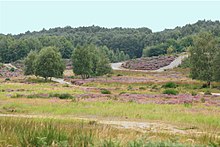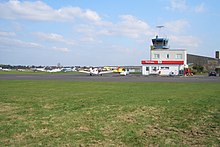Rhein-Sieg district
| coat of arms | Germany map |
|---|---|

|
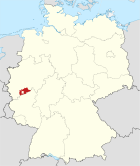
Coordinates: 50 ° 48 ' N , 7 ° 12' E |
| Basic data | |
| Existing period: | 1969– |
| State : | North Rhine-Westphalia |
| Administrative region : | Cologne |
| Regional association : | Rhineland |
| Administrative headquarters : | Siegburg |
| Area : | 1,153.21 km 2 |
| Residents: | 600,764 (Dec. 31, 2019) |
| Population density : | 521 inhabitants per km 2 |
| License plate : | SU |
| Circle key : | 05 3 82 |
| NUTS : | DEA2C |
| Circle structure: | 19 municipalities |
| Address of the district administration: |
Kaiser-Wilhelm-Platz 1 53721 Siegburg |
| Website : | |
| District Administrator : | Sebastian Schuster ( CDU ) |
| Location of the Rhein-Sieg district in North Rhine-Westphalia | |
The Rhein-Sieg-Kreis is a regional authority in the legal form of a district in the south of North Rhine-Westphalia . The district town is Siegburg , the most populous municipality is the city of Troisdorf . With its 600,764 inhabitants (December 31, 2019) it is the third largest district in Germany after the Hanover region and the Recklinghausen district . The Rhein-Sieg-Kreis belongs to the Cologne / Bonn region , the Rhineland metropolitan region and partly to the Rhine-Ruhr metropolitan region . It almost completely surrounds the independent federal city of Bonn and, together with it and the Rhineland-Palatinate district of Ahrweiler, forms the Bonn / Rhein-Sieg / Ahrweiler working group . The district is divided by the Rhine .
geography
Communities
(Residents on December 31, 2019)
| Surname | Administrative unit | population |
|---|---|---|
| Alfter | local community | 23,563 |
| Bad Honnef | Middle district city | 25,812 |
| Bornheim | Middle district city | 48,321 |
| Eitorf | local community | 18,749 |
| Hennef (victory) | Middle district city | 47,290 |
| Koenigswinter | Middle district city | 41,277 |
| Lohmar | Middle district city | 30,453 |
| Meckenheim | Middle district city | 24,817 |
| Much | local community | 14,412 |
| Neunkirchen-Seelscheid | local community | 19,679 |
| Niederkassel | Middle district city | 38,667 |
| Rheinbach | Middle district city | 26,986 |
| Ruppichteroth | local community | 10,420 |
| Saint Augustine | Middle district city | 55,847 |
| Siegburg | Middle district town (district town) | 41,554 |
| Swisttal | local community | 18,749 |
| Troisdorf | Large city belonging to the district | 74,953 |
| Wachtberg | local community | 20,485 |
| Windeck | local community | 18,730 |
| Rhein-Sieg district (total) | - | 600.764 |
Neighboring districts / cities
Starting in the north in a clockwise direction, the Rhein-Sieg-Kreis borders on the independent city of Cologne , the Rheinisch-Bergischen and Oberbergischen districts (all in North Rhine-Westphalia), the districts of Altenkirchen (Westerwald) , Neuwied and Ahrweiler (all in Rhineland-Palatinate ) as well as to the Euskirchen district and the Rhein-Erft district in North Rhine-Westphalia. The independent federal city of Bonn is almost completely enclosed by the district and borders on Rhineland-Palatinate in the extreme south.
Spatial structure
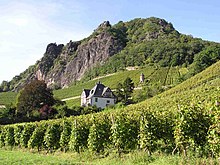


From a topographical point of view, the Rhein-Sieg district is extremely differentiated. The reason for this is the location between the Rhenish Slate Mountains and the Cologne-Bonn Bay . The Rhein-Sieg district is therefore characterized on the one hand by a low mountain range ( Siebengebirge , Drachenfelser Ländchen , Voreifel , Nutscheid , Leuscheid ) and on the other hand by wide, flatter areas near the rivers Rhine and Sieg . The highest mountain in the Rhein-Sieg district is the Großer Ölberg , which is part of the Siebengebirge, at 461 meters; the lowest point in the district, at 43 meters, is in the Niederkassel district of Lülsdorf am Rhein. From a topographical point of view, the various “terraces” of the Rhine, which were cut into the landscape over the course of millions of years, are striking.
The natural spatial form varies between meadows , mixed forests and agricultural or pasture areas . The forest area takes up almost 29% of the district area, the agricultural area almost 43%. This contrasts with a settlement area of a good 25%. Another 2% of the area is water . The socio-economic structure of the Rhein-Sieg district is just as diverse. Near the big cities of Bonn and Cologne , suburbanization has affected cities such as B. let Sankt Augustin grow strongly and make it more urban. In contrast, in the more distant communities such. B. Much more likely to be “rural idyll” and the community structure is more rural.
Nature parks
The nature parks Bergisches Land , Rhineland and Siebengebirge protrude into the Rhein-Sieg district . With 551, 334 and 38 square kilometers in the district (total 921 km²), 32.4% of the district is part of a nature park. In 2005, 9.3% of the district area was under nature protection and 55.5% under landscape protection . Since December 1, 2010, the Rhein-Sieg district has been participating in the federal funding program chance.natur under the project name “chance7 - we promote home”: “Natural and cultural landscape between Siebengebirge and Sieg”, which includes federal, state and District funds is promoted. Biotope network systems are to be created on an area of 12,000 hectares. The project has a term of twelve years and a funding volume of 12.5 million euros.
history

Early history
- By the Romans was Gaul conquered and left- Rhine against the free Germans secured the right of the Rhine. This was where the Roman garrison city of Bonn emerged alongside others . While the local Sugambri were crushed by Roman advances, other Germanic tribes such as the Ubier later settled peacefully to the left of the Rhine and were given land in exchange for military service. During the Roman Empire , the part of the Rhein-Sieg district on the left bank of the Rhine belonged to the Roman province of Lower Germany , while the part on the right bank of the Rhine belonged to the area of " free Germania ".
- In the 5th century, the Romans were ousted by the Franks . During this time the settlement of today's district began, later the first village was founded and the Christianization.
- In the Middle Ages , today's district was first part of the Bonngau and the Auelgau , and later belonged to different lordships. On the left bank of the Rhine it was essentially the Archbishopric of Cologne , on the right bank of the Rhine the Counts of Sayn with the castles Löwenburg , Blankenberg and Windeck and above all the Dukes of Berg . There were also numerous freedoms for monasteries or barons, which are explained in more detail in the individual municipalities.
- From 1794 the area on the left bank of the Rhine was occupied by France, from 1798 on the left bank of the current district belonged to the Rhine-Moselle department . Under French administration, serfdom was abolished on December 12, 1808, and fiefdom on January 11, 1811 . In addition to the redistribution of administrative areas cantons and Mairien , house numbers and civil civil status registers were also introduced (1798 on the left bank of the Rhine, 1810 on the right bank of the Rhine). The part on the right bank of the Rhine belonged to the Grand Duchy of Berg from 1806 .
1815-1945
- After the Congress of Vienna , the Rhineland became part of Prussia ; These formed in 1816, based on what is now the Rhein-Sieg district, initially the Rheinbach , Bonn , Siegburg , Uckerath and Waldbröl districts , which belonged to the Jülich-Kleve-Berg Province and from 1822 to the Rhine Province .
- In 1820 the districts of Siegburg and Uckerath were combined to form the district of Siegburg with headquarters in Siegburg , and in 1925 it was renamed Siegkreis .
- On May 3, 1854, District Administrator Franz von Wülffing founded the savings and loan fund
- In 1887 the city of Bonn left the district of Bonn and became an independent city
- 1918 to 1926 Allied occupation of the area on the right bank of the Rhine as far as Blankenberg
- In 1932, the victory circle around the office was Dattenfeld from the dissolved district Waldbroel and the District of Bonn is a major part of the dissolved circle Rheinbach increased
- In 1945 the area was occupied by Allied forces (primarily US) and later assigned to the British zone of occupation .
Since 1945
- As part of the first phase of municipal reorganization in North Rhine-Westphalia, the previous Siegkreis was expanded to include the newly created municipalities of Alfter, Bornheim, Meckenheim, Rheinbach, Swisttal and Wachtberg from the former district of Bonn on August 1, 1969 and became part of the Rhein-Sieg district renamed. The previous district of Bonn was dissolved. Part of this was combined with other municipalities to form the new city of Bonn, the rest - as described - incorporated into the Rhein-Sieg district. According to the wording of the law, the reform should come into force on July 1, 1969. Due to an urgent decision by the North Rhine-Westphalian Constitutional Court in Münster (the district of Bonn, the cities of Beuel and Bad Godesberg, as well as the communities of Uckerath, Wahlscheid, Oberkassel, Oberpleis, Stieldorf, Duisdorf, Lengsdorf and Witterschlick), the time of the In was postponed - Force kicking on August 1st, 1969.
- As part of the second phase of the municipal reorganization in North Rhine-Westphalia (preliminary work for the later “Cologne Act”), a. an assignment of the municipalities of Alfter, Meckenheim, Swisttal and Wachtberg to the city of Bonn and an integration of the city of Rheinbach into the district of Euskirchen are discussed. The city of Bornheim was to be divided between Cologne and Bonn (e.g. Roisdorf to Bonn and Sechtem or Walberberg to Cologne). However, this project could already be prevented during the consultation process, both by the Rhein-Sieg district and by the affected cities and communities.
- 1974–1978: Demolition of the former district office on Kaiser-Wilhelm-Platz in Siegburg and construction of today's district building at the same location.
- 1991: Bonn-Berlin resolution of the German Bundestag: The Bundestag's decision to move to Berlin has considerable effects on the Rhein-Sieg district, since a. Many municipalities in addition to Bonn perform so-called capital city functions (e.g. the seat of embassies and other authorities).
- 1994: Bonn-Berlin law comes into force. This establishes a division of labor between Berlin and the Bonn / Rhein-Sieg-Ahrweiler region with compensation regulations for the loss of the capital.
- Mid-1990s: Construction and construction of the Bonn-Rhein-Sieg University of Applied Sciences in Rheinbach and Sankt Augustin.
- End of the 1990s: Construction of the Cologne – Frankfurt ICE line and the new Siegburg / Bonn ICE train station .
- 1999: Relocation of the German Bundestag (after the summer break) to Berlin.
Population statistics
| year | Residents |
|---|---|
| 1970 | 376,800 |
| 1975 | 435.027 |
| 1980 | 463,537 |
| 1985 | 479.330 |
| 1990 | 504.274 |
| 1995 | 546.670 |
| 2000 | 576.993 |
| 2005 | 597.857 |
| 2010 | 598.736 |
| 2015 | 596.213 |
Denomination statistics
The district area was shaped by Catholicism from time immemorial . After the Prussian takeover of the Duchy of Berg , Prussian, mostly Protestant administrative officials came to the area, and after the end of the Second World War also many Protestant expellees . With the guest workers , Muslims and Greek Orthodox and, through Eastern European emigrants, Russian Orthodox believers also came to the district in large numbers. According to the 2011 census, 47.8% of the population were Catholic, 24.7% Protestant, 5.9% belonged to another and 21.5% did not belong to any religious community under public law . According to the Archdiocese of Cologne , there were around 268,500 Catholics (44.8%) in the Rhein-Sieg district in 2018. About 100,000 people (around 17%) belonged to the Protestant regional church . In 2019 there were 263,900 Catholics (43.9%) out of a total of 600,764 inhabitants.
politics
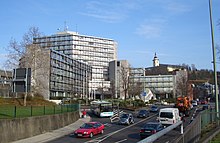
For the federal elections, the Rhein-Sieg district is divided into constituencies 097 and 098 ; directly elected members of these are currently Elisabeth Winkelmeier-Becker (CDU) and Norbert Röttgen (CDU). Sebastian Hartmann (SPD), Alexander Neu (Die Linke) and Nicole Westig (FDP) are members of the Bundestag via the state lists .
For the state elections in North Rhine-Westphalia, the Rhein-Sieg district is divided into the following four constituencies:
- Rhein-Sieg-Kreis I (25) - directly elected: Björn Franken (CDU)
- Rhein-Sieg-Kreis II (26) - directly elected: Andrea Milz (CDU), retired on June 29, 2017
- Rhein-Sieg-Kreis III (27) - directly elected: Oliver Krauss (CDU)
- Rhein-Sieg-Kreis IV (28) - directly elected: Katharina Gebauer (CDU)
Jörn Freynick (FDP) and Horst Becker (Greens) entered the state parliament via the respective state lists .
(Honorary) district administrators (at the time of the "dual leadership")
Due to a change in the law of the British military government , the previous office of district administrator was divided into the office of senior district director (as main administrative officer and thus head of administration) on the one hand and the office of a political (honorary) district administrator as chairman of the district council on the other (so-called dual leadership). Both the upper district director and the district administrator were elected by the district council. It was not until 1994 that the dual leadership was abolished through a change in the law of the North Rhine-Westphalian state parliament. However, the amendment provided for a transition period until 1999. However, the Rhein-Sieg district did not make use of the corresponding transitional regulation, so that the dual leadership did not expire until 1999.
- 1969–1974: Willi Lindlar (CDU)
- 1974–1999: Franz Möller (CDU)
Oberkreisdirektoren (main administrative officer at the time of the "dual leadership")
- 1969–1983: Paul Kieras (CDU)
- 1983–1995: Walter Kiwit (CDU)
- 1995–1999: Frithjof Kühn (CDU)
Since October 1, 1999 - as before 1946 - there has been no so-called “dual leadership” in the (Rhein-) Sieg district. The office of senior district director has been abolished. The district administrator is no longer voluntary, but full-time. He is also elected by the residents and no longer by the district council.
District administrators (as main administrative officials)
- 1999–2014 Frithjof Kühn (CDU)
- since June 23, 2014 Sebastian Schuster (CDU)
District Directors (general representatives of the main administrative officer)
- 1969–1977 Norbert Bestgen
- 1977–1983 Walter Kiwit
- 1983–1991 Günter Brahm
- 1991-2007 Monika Lohr
- since October 1, 2007 Annerose Heinze (CDU)
District council
The district council is the municipal representative body of the Rhein-Sieg district. The citizens decide on the composition every five years. The last election took place on May 25, 2014.
As of September 2014, the district council had the following distribution of seats according to parliamentary groups:
| CDU | SPD | Green | FDP | left | AfD | non-attached | total |
|---|---|---|---|---|---|---|---|
| 34 | 21st | 10 | 5 | 3 | 3 | 4th | 80 |
Non-attached parties with one seat each: pirates , FUW-free voters , referendum and NPD .
badges and flags
According to the main statute, the Rhein-Sieg district has a coat of arms, an official seal and a flag.
| Blazon : "In a silver shield, a blue-crowned and blue-armored, two-tailed red lion, who rests with his left paw on a silver shield with a black bar cross, with his right swings a golden sword of flames over his head." | |
|
Reasons for the coat of arms: The heraldic animal is the Bergische Löwe , which refers to the fact that the district on the right bank of the Rhine was part of the Duchy of Berg . The Kurkölnian cross in the silver shield indicates the areas of the district that were formerly part of Kurköln . The sword represents the flaming sword of the Archangel Michael, which symbolizes the Michaelsberg Abbey in Siegburg.
The coat of arms was awarded on May 26, 1955 by the Interior Minister of North Rhine-Westphalia . |
administration
The district police authority of the Rhein-Sieg district is responsible for the municipalities on the right bank of the Rhine except for Königswinter and Bad Honnef. These and the municipalities on the left bank of the Rhine are the responsibility of the Bonn Police Headquarters . Further responsibilities lie with the motorway police of the Cologne police headquarters and the federal police in the area of the railway premises.
The upper jurisdiction lies with the district court Bonn with the district courts Bonn , Königswinter , Rheinbach , Siegburg and Waldbröl for the district area.
Regional cooperation
The Rhein-Sieg district cooperates with Bonn and the district of Ahrweiler in the Regional Working Group for Development, Planning and Transport Bonn / Rhein-Sieg / Ahrweiler . In addition, the Rhein-Sieg district is part of the Cologne / Bonn region , a regional association in the form of a registered association .
Economy and Infrastructure
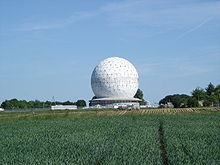
After the region had grown above average in the 1980s, economic losses were feared due to the government's move to Berlin. It turned out that the Rhein-Sieg district as an economic region with today's federal city of Bonn, together with its good transport infrastructure, successfully coped with the structural change. Since it was founded in 1969, there has been consistently high growth rates for jobs and companies. Due to the high potential of skilled workers, there are many start-ups and expansions of the economy, primarily in the service and information technology sector. In the Future Atlas 2016 , the district took 131st place out of 402 rural districts, municipal associations and independent cities in Germany, making it one of the regions with “future opportunities”.
This development can also be seen in the development of the population: In 2006 there were around 600,000 inhabitants, around 100,000 more than in 1990. Almost 140,000 inhabitants of the Rhein-Sieg district commute to work, most of them to Bonn (41,000) and Cologne (27,000 ).
In 2018, the Rhein-Sieg district had an above-average purchasing power index of 106.4 percent of the national average (100 percent) and is therefore a little below the federal city of Bonn (112.1). Bad Honnef (127.0 percent), Wachtberg (124.3), Königswinter (117.8), Meckenheim (112.8) and Lohmar (110.5 percent) are among the most affluent municipalities in the Rhein-Sieg district . The municipalities with the lowest purchasing power include Windeck (87.4 percent), Eitorf (90.6 percent), Ruppichteroth (93.1 percent) and Troisdorf (97.1 percent).
The most important shopping centers in the district are the HUMA shopping park in Sankt Augustin and Kaufland in Troisdorf.
traffic

In terms of transport, the district is well developed due to its location between Cologne and Bonn. Only the eastern part of the district is an exception here, as it is located between Bergisches Land and Westerwald . The following federal motorways run through the district:
- A 3 Emmerich am Rhein - Passau
- A 59 Dinslaken - Bonn
- A 61 Venlo - Ludwigshafen am Rhein
- A 555 Cologne - Bonn
- A 560 Sankt Augustin - Hennef
- A 565 Bonn - Meckenheim
In total there are approx. 81 km of federal motorways , approx. 137 km of federal highways , approx. 528 km of state roads and approx. 257 km of district-owned roads in the Rhein-Sieg district . As of January 1, 2018, 422,600 vehicles were registered, of which 357,167 were cars.
The district is also well connected to Deutsche Bahn routes:
- Cologne - Mainz ( Left Rhine route )
- Cologne - Wiesbaden ( right Rhine route )
- Cologne - Frankfurt am Main ( ICE - high-speed route Cologne - Rhine / Main )
- Cologne - Siegen ( victory route )
- Cologne - Gummersbach ( Aggertalbahn )
- Bonn - Euskirchen ( Voreifelbahn )
- Windeck-Au - Limburg an der Lahn ( Oberwesterwaldbahn )
The eastern part of the district is also largely developed through the victory route.
There are also the following light rail routes (locations in the Rhein-Sieg district are highlighted in bold ):
- Cologne - Wesseling - Bornheim - Bonn ( Rheinuferbahn )
- Bonn - Königswinter - Bad Honnef ( Siebengebirgsbahn )
- Bonn - Sankt Augustin - Siegburg ( Siegburg Railway )
- Cologne - Hürth - Brühl - Bornheim - Alfter - Bonn ( Vorgebirgsbahn )
The most important is the tram line 66 (Siegburg - Sankt Augustin - Bonn - Königswinter - Bad Honnef), which carries 56,000 passengers a day (see also Bonn tram ).
The Rhein-Sieg district is part of the tariff area of the Verkehrsverbund Rhein-Sieg (VRS).
The fourth largest German airport Cologne / Bonn is partly on the district area. The road connection is guaranteed via the A 59 and the rail connection via the airport loop . There is also the Bonn / Hangelar airfield (Sankt Augustin) and the Eudenbach glider airfield (Bad Honnef / Königswinter).
The Rhine as a navigable waterway has a length of 20.0 kilometers in a circle, a marina is located in Niederkassel- Mondorf .
Colleges and schools
In the Rhein-Sieg district are the
- University of Applied Sciences Bonn-Rhein-Sieg with locations in Sankt Augustin, Rheinbach and Hennef and around 8,000 students.
- International University of Applied Sciences Bad Honnef - Bonn (University of Applied Sciences) , Bad Honnef location
- Alanus University for Art and Society , Alfter
- State vocational college (glass college) , Rheinbach location
- Carl Reuther vocational college of the Rhein-Sieg district in Hennef
- Cologne University for Catholic Theology (KHKT) (St. Augustin, from 2021 in Cologne-Lindenthal)
- Drama School Siegburg (vocational school for performing stage arts) in Siegburg
A total of around 14,000 students were counted here in 2014.
On October 1, 2018, the location of the advanced training academy of the financial administration of North Rhine-Westphalia (FortAFin NRW) will be relocated from Bonn-Bad Godesberg to Bad Honnef. The school camp of the Rhein-Sieg district in Gemünd (Schleiden) was closed on December 31, 2015.
Culture
The life and work of the people in the Rhein-Sieg district and their culture are shown in numerous museums. See:
Former mining
In 1122 had Emperor Henry V of Abbey Siegburg granted a mining authorization. This meant that she owned several pits and had access to all mineral resources in her area. There is evidence that the Romans were already involved in mining in the Rhein-Sieg district . Archbishop Konrad von Hochstaden also ran mining here around 1250 in order to raise funds for the construction of Cologne Cathedral . You have to know that one ton of galena contained around 300 to 700 grams of silver . From this it can be concluded that the financing of the cathedral was supported with the silver won for coins, while the lead was used directly for the construction of the cathedral, namely for the connection of components and the roof covering. When zinc smelting was brought to industrial maturity in the middle of the 19th century , a real zinc rush broke out in the entire region. Mine operations were founded everywhere, which for a long time gave many people bread and work. See:
Standard land value
Building land prices in the district for residential development vary greatly between the urban zone and the rural communities. In Siegburg, prices between 185 and 320 euros per square meter are to be paid, in Windeck between 28 and 55 euros. The values typical for the region were decided on January 1, 2015 as follows:
| Commune | Typical land values in euros per square meter | ||
|---|---|---|---|
| Good location | Middle location | Simple location | |
| Alfter | 250 | 235 | 160 |
| Bad Honnef | 320 | 260 | 115 |
| Bornheim | 260 | 235 | 175 |
| Eitorf | 155 | 100 | 55 |
| Hennef (victory) | 270 | 150 | 70 |
| Koenigswinter | 235 | 190 | 110 |
| Lohmar | 190 | 170 | 100 |
| Meckenheim | 240 | 195 | 135 |
| Much | 135 | 90 | 44 |
| Neunkirchen-Seelscheid | 170 | 125 | 100 |
| Niederkassel | 290 | 260 | 210 |
| Rheinbach | 250 | 190 | 110 |
| Ruppichteroth | 120 | 75 | 50 |
| Saint Augustine | 270 | 250 | 225 |
| Siegburg | 320 | 235 | 185 |
| Swisttal | 200 | 175 | 85 |
| Troisdorf | 250 | 210 | 175 |
| Wachtberg | 260 | 205 | 125 |
| Windeck | 55 | 50 | 28 |
tourism
The Drachenfels (Siebengebirge) is the most visited mountain in Europe. The only commercially cultivated vineyards in North Rhine-Westphalia are located between the Siebengebirge and the Rhine, in the urban area of Königswinter and in the Bad Honnef district of Rhöndorf . The Deutsche Alleenstrasse , the Natursteig Sieg and the Rheinsteig lead through the Rhein-Sieg district .
Sports
- The TSV Germania Windeck (sporting qualification for the Regionalliga in the 2010/11 season) and VfL Alfter play in the football Middle Rhine league .
- The Neunkirchen Nightmares play baseball in the 1st Bundesliga and softball in the Bundesliga North .
- The Troisdorf Jets play American football in the 2nd Bundesliga.
- The SOBA Dragons Rhöndorf from Bad Honnef play in the 2nd basketball Bundesliga.
- The canoe polo club Pirat Bergheim plays in the Bundesliga.
In 2007, the Kreissportbund had around 158,000 members in 582 clubs.
Buildings
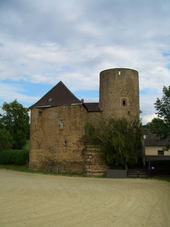
- List of monasteries in the Rhein-Sieg district
- List of Jewish cemeteries in the Rhein-Sieg district
- List of castles and palaces in the Rhein-Sieg district
License Plate
Initially, the license plate SB (after the district town of Siegburg) was intended for the Siegkreis . When it became known that the Saarland would join the Federal Republic of Germany on January 1, 1957, the assignment was changed at short notice in favor of the larger Saarbrücken (see extension of the system to Saarland 1957 ). On July 1, 1956, the Siegkreis was assigned the distinguishing mark SU when the vehicle registration number that is still valid today was introduced . It is issued throughout the Rhein-Sieg district to this day. Vehicles that were registered in what was then the district of Bonn until 1969 because owners lived in communities that formerly belonged to this district and are now in the Rhein-Sieg district, still bear the BN license plate , which is no longer in the Rhein-Sieg district. Circle is awarded.
See also
literature
- August Horn: The Siegthal - from the mouth of the river to the source. Published by T. Habicht, Bonn 1854.
- Ernst Weyden: The Siegthal - from the mouth of the river to the source. Adolf Lesimple's publishing house, Leipzig 1865.
- Aenne Hansmann: Old RSK archive - documents, sources on the history of the Rhein-Sieg district, vol. 7th 1977.
- Reinhard Zado: Vines, wood and iron - The Siegtal from the mouth to the source. Edition Blattwelt, Niederhofen 2009, ISBN 978-3-936256-37-6 .
- E. Renard (arrangement): Die Kunstdenkmäler des Siegkreises (= Die Kunstdenkmäler der Rheinprovinz . Volume 5.4 ). Düsseldorf 1907.
- Herbert Schmidt: From the forest and forest history of the Siegkreis. An evaluation of the archive of the State Forestry Office Siegburg (= publication of the history and antiquity association for Siegburg and the Rhein-Sieg-Kreis eV Volume 10). Siegburg 1973.
- Herbert Weffer (arr.): The files of the district of Bonn (= sources on the history of the Rhein-Sieg district. Volume 13). Siegburg 1992.
- Claudia Maria Arndt, Sven Kuttner u. Monika Marner: Bibliography on Jewish history and culture in the Rhein-Sieg district. Ludwig Maximilians University, Munich 2005 ( full text as PDF ).
Web links
Individual evidence
- ↑ Population of the municipalities of North Rhine-Westphalia on December 31, 2019 - update of the population based on the census of May 9, 2011. State Office for Information and Technology North Rhine-Westphalia (IT.NRW), accessed on June 17, 2020 . ( Help on this )
- ↑ Chance7 - The Project. Rhein-Sieg-Kreis, project chance7, accessed on November 15, 2016 .
- ↑ Chance7 - a new home for nature conservation. (PDF) press release. move: elevator, December 12, 2012, accessed November 15, 2016 .
- ^ Theodor Rutt: Land on Sieg and Rhine - History-Culture-Economy. Scientific archive, Urkunde-Bild-Chronic GmbH, Bonn 1960.
- ↑ Law on the local reorganization of the Bonn area, Law and Ordinance Gazette for the State of North Rhine-Westphalia 1969, p. 236 ff. And VGH 13/69, 14/69, 16/69, 22/69, 34/69, 35 / 69, 36/69, 38/69, 41/69
- ↑ Franz Möller: The Rhein-Sieg-Kreis in the area of tension between the federal government and the state 1949-2000. Siegburg 2005.
- ^ State database North Rhine-Westphalia
- ↑ Census database of the 2011 census, accessed on December 8, 2016
- ^ Rhein-Sieg-Anzeiger: Leaving the Church. People in the Rhein-Sieg district turn their backs on churches , January 10, 2020.
- ^ Archdiocese of Cologne: erzbistum-koeln.de: Community life in the Archdiocese of Cologne , accessed on July 11, 2020.
- ^ Rhein-Sieg-Kreis. District election - overall result. May 25, 2014, accessed June 16, 2014 .
- ↑ a b Main statutes for the Rhein-Sieg district of March 31, 2000, last amended by statutes of December 13, 2013. (PDF; 2.5 MB) In: rhein-sieg-kreis.de. Rhein-Sieg-Kreis, archived from the original ; Retrieved July 17, 2016 .
- ↑ circle crest Rhein-Sieg-Kreis ( Memento of 7 April 2009 at the Internet Archive )
- ↑ Purchasing power and purchasing power and turnover data for 2018 in the Bonn / Rhein-Sieg region (forecast values). (PDF; 15 kB) Chamber of Commerce and Industry Bonn / Rhein-Sieg, accessed on November 24, 2019 .
- ↑ Mobility in North Rhine-Westphalia - data and facts 2018/2019. In: Road traffic. Ministry for Building, Housing, Urban Development and Transport of the State of North Rhine-Westphalia, pp. 35, 66 (PDF; 14.2 MB, holdings on January 1, 2018).
- ↑ New tenants for the former Commundo in Bad Honnef , General-Anzeiger , July 17, 2018
- ^ Rhein-Sieg-Rundschau v. July 19, 2016, p. 34: Last signpost dismantled (bk)
- ↑ Peter Zenker: Mining in Seligenthal and Weingartsgasse - The Ziethen pit, accessed on October 8, 2016
- ^ Herbert Stahl (editor), Gerhard Geurts , Herbert Ommer : Das Erbe des Erzes , Volume 2: The pits on the Gangerz deposits in the ore district of Bensberg . Cologne 2004, ISBN 3-00-014668-7 .
- ↑ Land market report 2015 for the Rhein-Sieg district. (PDF) reporting period 2014. The expert committee for property values in the Rhein-Sieg district and in the city of Troisdorf, March 25, 2015, p. 69 , archived from the original ; accessed on May 10, 2019 (free edition).
- ^ Siebengebirge - Riviera am Rhein , Spiegel Online




